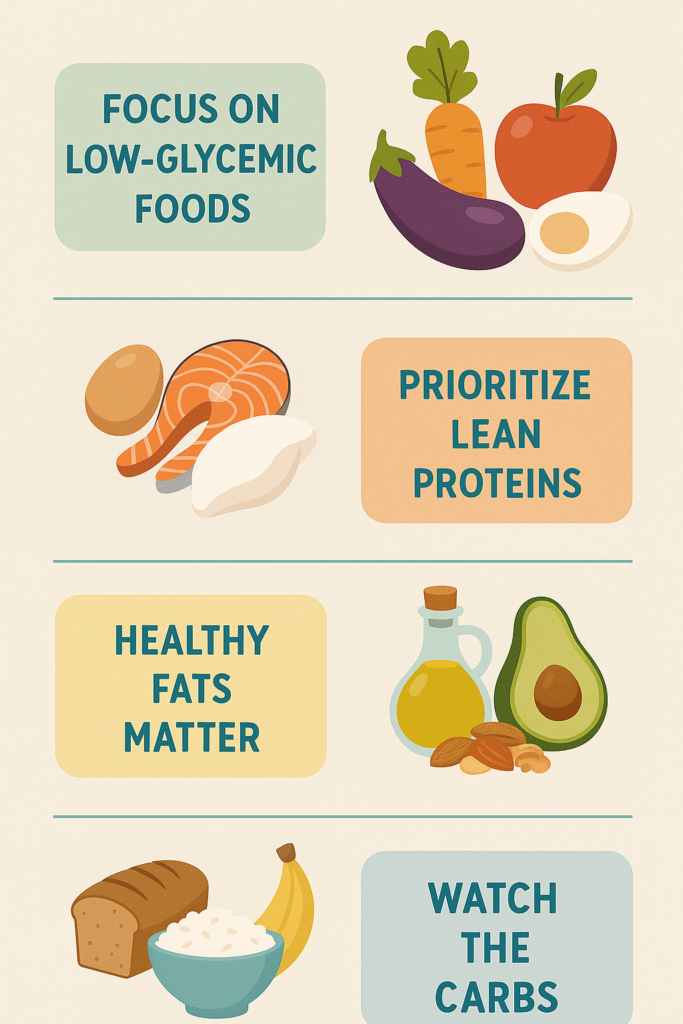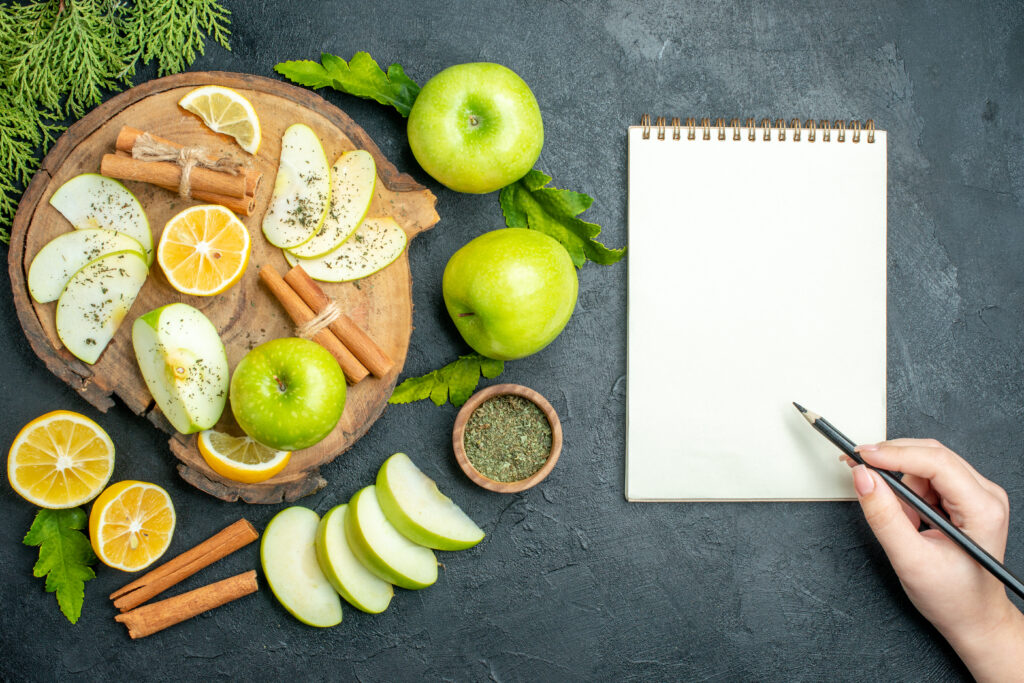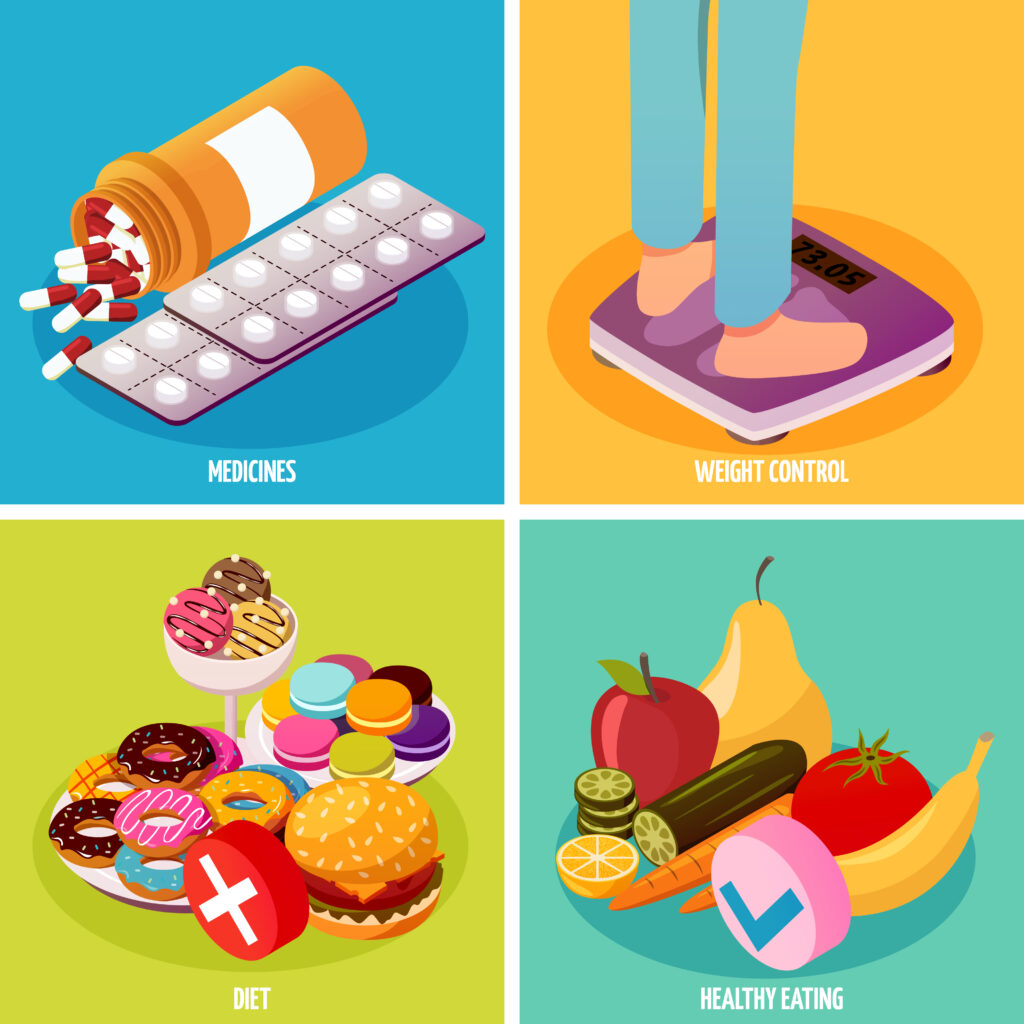A diabetic diet doesn’t have to deprive you! All you need is controlled lifestyle and balanced meal plans. Whether Type 1, Type 2, or gestational diabetes, you can manage your blood sugar levels with smart food choices. Feel your best and prevent complications.
Goals of a Diabetic Diet
- Keep blood glucose levels stable throughout the day.
- Maintain a healthy weight.
- Prevent spikes and crashes that affect energy and mood.
- Support heart health, which is closely tied to diabetes.
Key Principles of a Diabetic Diet Meal Planning

1. For A Diabetic Diet, Focus on Low-Glycemic Foods
Combine high-GI foods with protein or healthy fats to lower the overall GI of your meal to release glucose slowly. Choose food like:
- Whole grains (oats, brown rice, quinoa, barley, buckwheat)
- Non-starchy vegetables (leafy greens, bell peppers, broccoli, spinach, kale, zucchini,)
- Legumes (lentils, chickpeas, black beans, kidney beans)
- Fruits with fiber (berries, apples, pears, cherries, berries) (eat in moderation)
2. Prioritize Lean Proteins
Protein helps slow digestion, reducing and stabilizing the blood sugar spike that comes after meals. It also keeps you fuller longer, which helps prevent overeating and snacking. Aim to include some protein at every meal and snack to balance blood sugar levels.
- Eggs (especially boiled or poached)
- Tofu, tempeh, seitan
- Skinless chicken or turkey
- Fatty Fish (especially salmon, mackerel) (rich in omega-3s)
- Greek yogurt (unsweetened) or cottage cheese
3. Healthy Fats – A Good Friend in Moderation
Healthy fats don’t spike blood sugar as it helps slow sugar absorption and help you absorb fat-soluble vitamins. They also improve satiety and brain function, both of which are crucial for long-term health. But choose the right kind:
Best sources of healthy fats:
- Avocados
- Nuts and seeds: walnuts, almonds, pistachios (unsalted)
- Olive oil, flaxseed oil, Extra virgin olive oil
- Fatty fish (again, think salmon or sardines)
Add avocado to toast, drizzle olive oil over veggies, or blend flax seeds into smoothies for easy healthy fat intake.
4. Watch the Carbs Intake (But don’t cut them Out!)
We all know carbohydrates directly affect blood sugar and affects the most. But carbs are not the enemy, quality and quantity are what matter most. Carb counting or tracking may help at first. Many diabetics aim for 30–45g of carbs per meal depending on individual needs.
Smart carb strategies:
- Count your carb intake per meal (often 30–60g depending on your plan)
- Swap refined carbs for whole food alternatives (white bread → whole grain, sugary cereal → steel-cut oats). Choose whole, high-fiber carbs like whole grains, beans, fruits, vegetables. Stick to these complex carbs over refined ones
- Spread your carbs evenly throughout the day
- Limit added sugars and refined flours

5. Make Fiber Your Friend
Fiber slows the absorption of sugar into the bloodstream and improves insulin sensitivity. Aim for at least 25–30g of fiber daily, and increase water intake as you do.
Some fiber-rich foods:
- Beans and lentils
- Berries and pears (with skin)
- Broccoli, carrots, Brussels sprouts
- Whole grains: oats, bulgur, quinoa
- Nuts and seeds
6. Hydrate Smart
Staying hydrated helps flush excess sugar from your bloodstream and keeps your metabolism running smoothly. Dehydration can elevate blood sugar levels. Aim for 8–10 glasses of water a day. Avoid sugary drinks—even fruit juices can cause spikes. If you’re craving fizz, try sparkling water with a splash of lemon or lime juice.
Smart drink choices:
- Water (plain or infused with lemon, mint, cucumber)
- Herbal teas
- Black coffee (without added sugar or cream)
- Avoid sugary drinks, soda, fruit juices, or energy drinks
For Your Diabetic Diet, Remember to Avoid or Limit
- Refined sugars (candies, soda, packaged sweets)
- Processed carbs (white bread, pastries, chips)
- Trans fats (found in fried fast food, some baked goods)
- Sugary beverages (opt for water, herbal tea, or sparkling water with lemon)
- Large portion sizes
Diabetic Diet Tips For Practical Implementation

Stay Consistent with Meal Timing. Eat at regular intervals (every 3–4 hours) to avoid blood sugar crashes or spikes. Skipping meals can be risky.
Exercise regularly / Stay physically active. Even light daily walks help regulate glucose by improving insulin sensitivity
Learn to Read food labels. Watch out for hidden sugars like dextrose, maltose, or syrup. Even “low-fat” options can be high in carbs or added sugar.
Monitor blood sugar. Track how different foods affect your levels
Create a Carb Budget. Think of your daily carb intake like a spending budget—plan it wisely across meals and snacks to avoid sugar spikes. Use apps like MyFitnessPal or Carb Manager to track your intake.
Practice portion control. Use the plate method.
Visualize your plate in 3 parts:
½ with non-starchy veggies (like spinach, broccoli, bell peppers),
¼ with lean protein (chicken, tofu, fish),
¼ with whole grains or complex carbs (quinoa, brown rice).
This is diabetic diet friendly plate!
Practice the 10-Minute Rule for Cravings. When a sugar craving strikes, wait 10 minutes. Drink a glass of water, take a walk, or distract yourself—often the urge will pass.
When possible, cook more at home. Restaurant and packaged foods often have hidden sugars, salt, and unhealthy fats. Even simple homemade meals can be more diabetes-friendly.
Work with professionals. Consult with a registered dietitian for personalized guidance

Sample of a Diabetic Diet Friendly Day
Breakfast: Greek yogurt with chia seeds, berries & cinnamon
Lunch: Grilled chicken salad with olive oil dressing & a slice of whole-grain bread. Recipe.
Snack: Handful of almonds or apple slices with nut butter
Dinner: Baked salmon, roasted veggies, and quinoa. Recipe.
Drink: Cinnamon tea or infused water with mint & cucumber. Recipe.
Read about Diet here.
Related health post:










